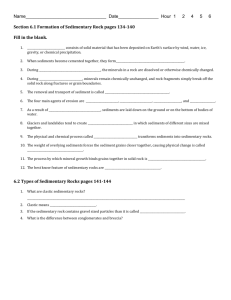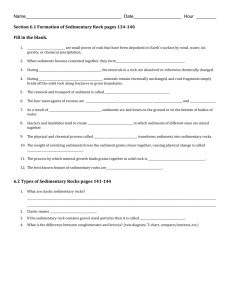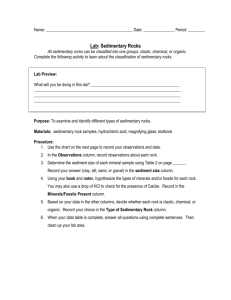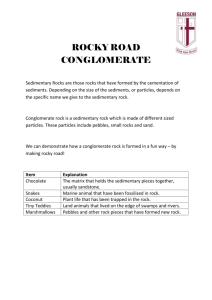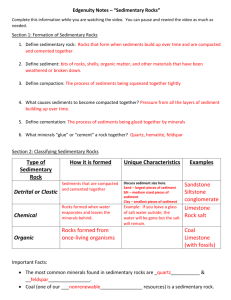01 - Ionia Public Schools
advertisement
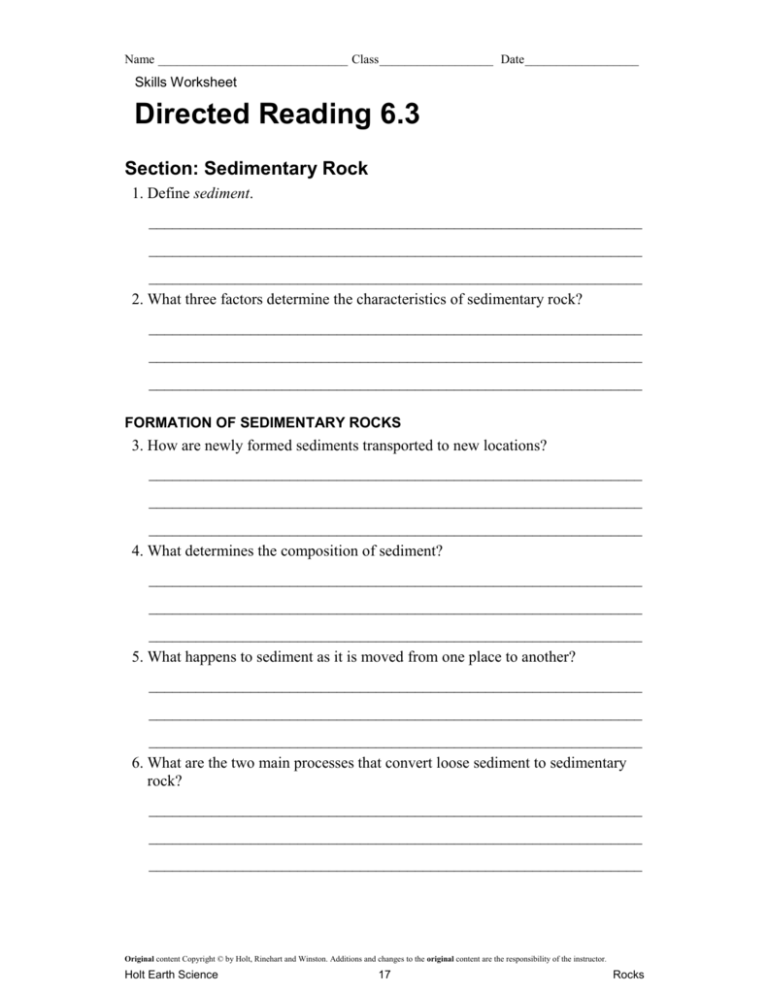
Name ______________________________ Class __________________ Date __________________ Skills Worksheet Directed Reading 6.3 Section: Sedimentary Rock 1. Define sediment. _______________________________________________________________ _______________________________________________________________ _______________________________________________________________ 2. What three factors determine the characteristics of sedimentary rock? _______________________________________________________________ _______________________________________________________________ _______________________________________________________________ FORMATION OF SEDIMENTARY ROCKS 3. How are newly formed sediments transported to new locations? _______________________________________________________________ _______________________________________________________________ _______________________________________________________________ 4. What determines the composition of sediment? _______________________________________________________________ _______________________________________________________________ _______________________________________________________________ 5. What happens to sediment as it is moved from one place to another? _______________________________________________________________ _______________________________________________________________ _______________________________________________________________ 6. What are the two main processes that convert loose sediment to sedimentary rock? _______________________________________________________________ _______________________________________________________________ _______________________________________________________________ Original content Copyright © by Holt, Rinehart and Winston. Additions and changes to the original content are the responsibility of the instructor. Holt Earth Science 17 Rocks Name ______________________________ Class __________________ Date __________________ Directed Reading continued 7. The process in which the volume and porosity of a sediment is reduced by the weight and pressure of overlying sediments is called ______________________. 8. The process in which minerals precipitate into pore spaces between sediment grains and bind sediments together to form rock is called ______________________. CHEMICAL SEDIMENTARY ROCK _____ 9. Sedimentary rock that forms when minerals precipitate from a solution or settle from a suspension is called a. organic sedimentary rock. b. chemical sedimentary rock. c. clastic sedimentary rock. d. elastic sedimentary rock. _____ 10. One reason that minerals precipitate is because of a. evaporation. b. compaction. c. cementation. d. condensation. _____ 11. When water evaporates, it leaves behind minerals called a. metamorphites. b. magma. c. crystals. d. evaporites. _____ 12. Two examples of evaporites are a. coal and granite. b. gypsum and halite. c. chalk and limestone. d. sandstone and shale. _____ 13. The Bonneville Salt Flats near the Great Salt Lake in Utah are a good example of a. evaporite deposits. b. coal deposits. c. limestone deposits. d. shale deposits. Original content Copyright © by Holt, Rinehart and Winston. Additions and changes to the original content are the responsibility of the instructor. Holt Earth Science 18 Rocks Name ______________________________ Class __________________ Date __________________ Directed Reading continued ORGANIC SEDIMENTARY ROCKS Use the terms from the following list to complete the sentences below. Each term may be used only once. Some terms will not be used. chalk coral calcite coal organic sedimentary rock carbon limestone 14. Sedimentary rock that forms from the remains of plants or animals is called ______________________. 15. Some limestones and ______________________ are examples of organic sedimentary rocks. 16. Coal forms from plant remains that are buried before they decay and are then compacted into matter that is composed mainly of ______________________. 17. Organic limestone forms when marine organisms such as coral, clams, oysters, and plankton remove chemical components of the minerals ______________________ and aragonite from sea water. 18. When marine organisms die, their shells eventually become ______________________. 19. An example of limestone made up of the shells of tiny, one-celled marine organisms that settle to the ocean floor is ______________________. CLASTIC SEDIMENTARY ROCK In the space provided, write the letter of the description that best matches the term or phrase. _____ 20. clastic sedimentary rock _____ 21. conglomerate _____ 22. breccia _____ 23. sandstone _____ 24. shale _____ 25. quartz a. mineral that is a major component of most sandstones b. rock composed of angular fragments with sharp corners that range in size from fine mud to boulders c. sedimentary rock that forms when fragments of preexisting rocks are compacted or cemented together d. rock made up of sand-sized grains cemented together e. rock that consists of clay-sized particles that are cemented and compacted f. rock composed of rounded fragments sized from fine mud to boulders Original content Copyright © by Holt, Rinehart and Winston. Additions and changes to the original content are the responsibility of the instructor. Holt Earth Science 19 Rocks Name ______________________________ Class __________________ Date __________________ Directed Reading continued CHARACTERISTICS OF CLASTIC SEDIMENTS 26. What two factors determine the physical characteristics of sediments? _______________________________________________________________ _______________________________________________________________ 27. Name the four agents that transport sediments. _______________________________________________________________ _______________________________________________________________ _______________________________________________________________ _______________________________________________________________ 28. How does the speed with which the agent of erosion moves the sediment affect that sediment? _______________________________________________________________ _______________________________________________________________ 29. Define sorting. _______________________________________________________________ _______________________________________________________________ 30. How do poorly sorted and well-sorted sediments differ? _______________________________________________________________ _______________________________________________________________ 31. What causes sediment to change in size and shape as it is transported from its source to where it is deposited? _______________________________________________________________ _______________________________________________________________ 32. In general, how do sediment particles that travel long distances differ from those that have traveled short distances? _______________________________________________________________ _______________________________________________________________ _______________________________________________________________ Original content Copyright © by Holt, Rinehart and Winston. Additions and changes to the original content are the responsibility of the instructor. Holt Earth Science 20 Rocks Name ______________________________ Class __________________ Date __________________ Directed Reading continued SEDIMENTARY ROCK FEATURES In the space provided, write the letter of the description that best matches the term or phrase. _____ 33. depositional environment _____ 34. stratification _____ 35. bed _____ 36. massive bed _____ 37. cross-bed _____ 38. graded bedding _____ 39. reverse grading a. a stratified layer b. a bed characterized by slanting layers c. a type of stratification in which various sizes and kinds of materials are deposited in one layer d. a bed with no internal structure e. a type of stratification in which the smallest grains are on the bottom and larger grains are on top f. the layering of sedimentary rock, which occurs when the conditions of deposition change g. the setting in which sediment is deposited 40. A sedimentary rock feature caused by the action of wind or water on sand is called a(n) ______________________. 41. A sedimentary rock feature that forms when a muddy deposit dries and shrinks is called a(n) ______________________ 42. How are fossils formed? _______________________________________________________________ _______________________________________________________________ 43. How are concretions formed? _______________________________________________________________ _______________________________________________________________ 44. How are geodes formed? _______________________________________________________________ _______________________________________________________________ Original content Copyright © by Holt, Rinehart and Winston. Additions and changes to the original content are the responsibility of the instructor. Holt Earth Science 21 Rocks ANSWER.KEY Original content Copyright © by Holt, Rinehart and Winston. Additions and changes to the original content are the responsibility of the instructor. Holt Earth Science 58 Rocks




